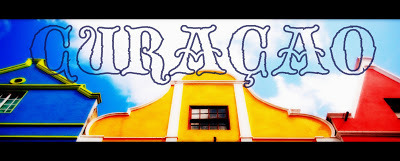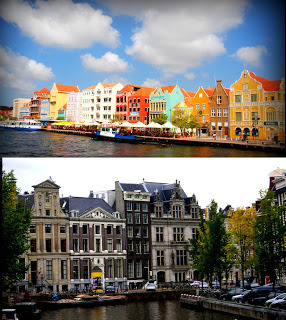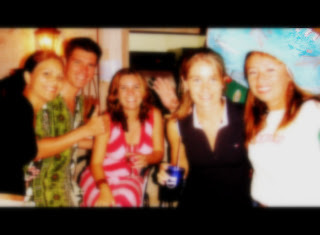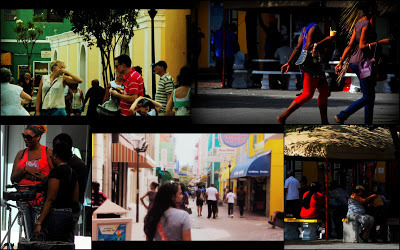A to Z: C is for Curaçao
Ah, finally: dushi Kòrsou. (More tomorrow on Dushi, for D day.)

The most popular question about Curaçao (besides where is it, which, if you read the A post, you're already among the elite 3%* of the world's population who can answer that) is about its name.
 Aside from grey and drab vs. bright and fun,
Aside from grey and drab vs. bright and fun,
you do see the similarities, right?What does it mean? Where does it come from? Is it Portuguese? Spanish? Dutch? No, couldn't be Dutch. But Portuguese... The word for heart in the language of samba and cachaça is coração--that's pretty close, isn't it?
But there's another theory: the island's first inhabitants were Arawak indians that may or may not have called themselves Curacoa or, perhaps, Curaçao.
The thing about Curaçao is that there's simply too many possibilities. Not just for explaining the name.
Think about it: it's a Caribbean island that belongs to the Kingdom of The Netherlands (more on that for G day), thus has a definite European influence.
Lots of Dutch people move here when they retire. Lots vacation here regularly, even own second homes or businesses here. On finishing high school, most Curaçao kids go to Holland for college. That shapes them in ways those of us that grew up in a single country can't even begin to fathom.
 UN in the Caribbean. From left to right:
UN in the Caribbean. From left to right:
Venezuela, Curaçao, Italy, hand of unknown nationality,
Denmark, Mexico. But Curaçao is firmly rooted in Latin America, too. Just off the coast of Venezuela (on clear days you can see the mountain range of Caracas), but with European-style government and a thriving finance industry, it's only logical that this island be a magnet for immigrants. Colombian and Venezuelan, certainly, but also from other parts in the Caribbean: Dominican Republic, Haiti, Jamaica, Trinidad & Tobago. From further south, too: Argentina, Chile, Uruguay, Brazil.
(No, not a lot of Mexicans. A river's easier to cross than the Caribbean.)
And then there's the local Antillean population, another sincretism: descended from African slaves brought here by slave traders in the 1700's and 1800's, mixed with the Dutch and Portuguese settlers, later with Latin and Asian immigrants. So rich, so much tradition to choose from.
Curaçao is the original melting pot of culture. And contrast.
 Tourists, locals, Latin, European... Impossible to tell apart.
Tourists, locals, Latin, European... Impossible to tell apart.
European / Latin. Black / white. Laid-back attitude / 12-hour working days. Dry, semi-desertic landscape / the bluest ocean you'll ever see. Red earth baked into powder by a sun so strong its heat pushes you down / white beaches of coral pounded into sand by eons of tides. Friendly faces / surly service. Luxury villas / hovels and homeless.
In ten years, I've barely scratched the surface of what this island--its history, its inhabitants, its future--has to offer.
Go on, take a hop over to the other A-Z Bloggers. Share the love!
*Yeah, totally made up that figure.

The most popular question about Curaçao (besides where is it, which, if you read the A post, you're already among the elite 3%* of the world's population who can answer that) is about its name.
 Aside from grey and drab vs. bright and fun,
Aside from grey and drab vs. bright and fun,you do see the similarities, right?What does it mean? Where does it come from? Is it Portuguese? Spanish? Dutch? No, couldn't be Dutch. But Portuguese... The word for heart in the language of samba and cachaça is coração--that's pretty close, isn't it?
But there's another theory: the island's first inhabitants were Arawak indians that may or may not have called themselves Curacoa or, perhaps, Curaçao.
The thing about Curaçao is that there's simply too many possibilities. Not just for explaining the name.
Think about it: it's a Caribbean island that belongs to the Kingdom of The Netherlands (more on that for G day), thus has a definite European influence.
Lots of Dutch people move here when they retire. Lots vacation here regularly, even own second homes or businesses here. On finishing high school, most Curaçao kids go to Holland for college. That shapes them in ways those of us that grew up in a single country can't even begin to fathom.
 UN in the Caribbean. From left to right:
UN in the Caribbean. From left to right: Venezuela, Curaçao, Italy, hand of unknown nationality,
Denmark, Mexico. But Curaçao is firmly rooted in Latin America, too. Just off the coast of Venezuela (on clear days you can see the mountain range of Caracas), but with European-style government and a thriving finance industry, it's only logical that this island be a magnet for immigrants. Colombian and Venezuelan, certainly, but also from other parts in the Caribbean: Dominican Republic, Haiti, Jamaica, Trinidad & Tobago. From further south, too: Argentina, Chile, Uruguay, Brazil.
(No, not a lot of Mexicans. A river's easier to cross than the Caribbean.)
And then there's the local Antillean population, another sincretism: descended from African slaves brought here by slave traders in the 1700's and 1800's, mixed with the Dutch and Portuguese settlers, later with Latin and Asian immigrants. So rich, so much tradition to choose from.
Curaçao is the original melting pot of culture. And contrast.
 Tourists, locals, Latin, European... Impossible to tell apart.
Tourists, locals, Latin, European... Impossible to tell apart.European / Latin. Black / white. Laid-back attitude / 12-hour working days. Dry, semi-desertic landscape / the bluest ocean you'll ever see. Red earth baked into powder by a sun so strong its heat pushes you down / white beaches of coral pounded into sand by eons of tides. Friendly faces / surly service. Luxury villas / hovels and homeless.
In ten years, I've barely scratched the surface of what this island--its history, its inhabitants, its future--has to offer.
Go on, take a hop over to the other A-Z Bloggers. Share the love!
*Yeah, totally made up that figure.
Published on April 02, 2013 23:00
No comments have been added yet.



